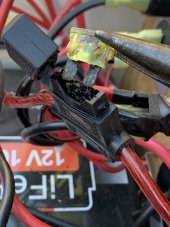About a year ago, I put together a battery setup for camping, mostly based on reading posts on these forums. For this setup, I use a couple 100 watt panels in series, an Ampere Time 100Ah LiFePO4 battery, an EPever Tririon2210N controller with MT50, and a 24V 15A power supply feeding the charge controller's solar input when charging at home. This setup has worked perfectly for numerous camping trips. This past weekend, I didn't take panels, since we were pressed for space, and the battery never dropped below 45%.
When I got home, I noticed the battery appeared to charge much quicker than normal. Instead of actually charging, it had stopped at 45.4% with a battery voltage of 10.5. When I first connect AC to the power supply, the MT50 shows it charging at 14.6V 10A for a couple seconds with the solar input (power supply) at 24V. Then, the output voltage from the power supply still shows 24V but zero amps. Also, I noticed that the controller LED that's normally green for the battery is now red, likely due to the low voltage, I assume.
I've verified the input voltage to the controller and the battery's voltage with a separate meter. I used parameters I found here to set up the controller, and they are listed below. Basically, I need some help troubleshooting this and can certainly do any testing necessary to help with this. My first thoughts were that a setting is wrong, and the battery is at a lower state than normal, but now I wonder if the power supply is at fault. I don't have a spare power supply but can order one if necessary. Thanks much in advance!
Over Voltage Disconnect 14.8
Charging Limit Voltage 14.6
Over Voltage Rec. Voltage 14.6
Equalize Charging Voltage 14.4
Boost Charging Voltage 14.4
Float Charging Voltage 13.8
Boost Reconnect Voltage 14.4
Low Voltage Reconnect Voltage 11.8
Under Voltage Warning Rec. Volt 11.8
Under Voltage Warning Voltage 11.5
Low Voltage Disconnect Voltage 11.1
Discharging Limit Voltage 10.8
Equalize Duration 0
Boost Duration 180 mins
When I got home, I noticed the battery appeared to charge much quicker than normal. Instead of actually charging, it had stopped at 45.4% with a battery voltage of 10.5. When I first connect AC to the power supply, the MT50 shows it charging at 14.6V 10A for a couple seconds with the solar input (power supply) at 24V. Then, the output voltage from the power supply still shows 24V but zero amps. Also, I noticed that the controller LED that's normally green for the battery is now red, likely due to the low voltage, I assume.
I've verified the input voltage to the controller and the battery's voltage with a separate meter. I used parameters I found here to set up the controller, and they are listed below. Basically, I need some help troubleshooting this and can certainly do any testing necessary to help with this. My first thoughts were that a setting is wrong, and the battery is at a lower state than normal, but now I wonder if the power supply is at fault. I don't have a spare power supply but can order one if necessary. Thanks much in advance!
Over Voltage Disconnect 14.8
Charging Limit Voltage 14.6
Over Voltage Rec. Voltage 14.6
Equalize Charging Voltage 14.4
Boost Charging Voltage 14.4
Float Charging Voltage 13.8
Boost Reconnect Voltage 14.4
Low Voltage Reconnect Voltage 11.8
Under Voltage Warning Rec. Volt 11.8
Under Voltage Warning Voltage 11.5
Low Voltage Disconnect Voltage 11.1
Discharging Limit Voltage 10.8
Equalize Duration 0
Boost Duration 180 mins



